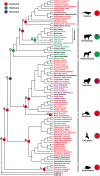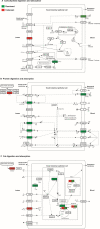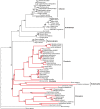Diet evolution of carnivorous and herbivorous mammals in Laurasiatheria
- PMID: 35729512
- PMCID: PMC9210794
- DOI: 10.1186/s12862-022-02033-6
Diet evolution of carnivorous and herbivorous mammals in Laurasiatheria
Abstract
Background: Laurasiatheria contains taxa with diverse diets, while the molecular basis and evolutionary history underlying their dietary diversification are less clear.
Results: In this study, we used the recently developed molecular phyloecological approach to examine the adaptive evolution of digestive system-related genes across both carnivorous and herbivorous mammals within Laurasiatheria. Our results show an intensified selection of fat and/or protein utilization across all examined carnivorous lineages, which is consistent with their high-protein and high-fat diets. Intriguingly, for herbivorous lineages (ungulates), which have a high-carbohydrate diet, they show a similar selection pattern as that of carnivorous lineages. Our results suggest that for the ungulates, which have a specialized digestive system, the selection intensity of their digestive system-related genes does not necessarily reflect loads of the nutrient components in their diets but appears to be positively related to the loads of the nutrient components that are capable of being directly utilized by the herbivores themselves. Based on these findings, we reconstructed the dietary evolution within Laurasiatheria, and our results reveal the dominant carnivory during the early diversification of Laurasiatheria. In particular, our results suggest that the ancestral bats and the common ancestor of ruminants and cetaceans may be carnivorous as well. We also found evidence of the convergent evolution of one fat utilization-related gene, APOB, across carnivorous taxa.
Conclusions: Our molecular phyloecological results suggest that digestive system-related genes can be used to determine the molecular basis of diet differentiations and to reconstruct ancestral diets.
Keywords: Carnivores; Dietary evolution; Digestive system genes; Herbivores; Positive selection.
© 2022. The Author(s).
Conflict of interest statement
We have no competing interests to declare.
Figures



Similar articles
-
Arms race of temporal partitioning between carnivorous and herbivorous mammals.Sci Rep. 2018 Jan 29;8(1):1713. doi: 10.1038/s41598-018-20098-6. Sci Rep. 2018. PMID: 29379083 Free PMC article.
-
Reconstruction of evolutionary changes in fat and toxin consumption reveals associations with gene losses in mammals: A case study for the lipase inhibitor PNLIPRP1 and the xenobiotic receptor NR1I3.J Evol Biol. 2022 Feb;35(2):225-239. doi: 10.1111/jeb.13970. Epub 2022 Jan 11. J Evol Biol. 2022. PMID: 34882899
-
Molecular evolution of dietary shifts in ladybird beetles (Coleoptera: Coccinellidae): from fungivory to carnivory and herbivory.BMC Biol. 2025 Feb 28;23(1):67. doi: 10.1186/s12915-025-02174-2. BMC Biol. 2025. PMID: 40022128 Free PMC article.
-
On the Origin of Carnivory: Molecular Physiology and Evolution of Plants on an Animal Diet.Annu Rev Plant Biol. 2021 Jun 17;72:133-153. doi: 10.1146/annurev-arplant-080620-010429. Epub 2021 Jan 12. Annu Rev Plant Biol. 2021. PMID: 33434053 Review.
-
Energetics and the evolution of carnivorous plants--Darwin's 'most wonderful plants in the world'.J Exp Bot. 2009;60(1):19-42. doi: 10.1093/jxb/ern179. J Exp Bot. 2009. PMID: 19213724 Review.
Cited by
-
Convergent relaxation of molecular constraint in herbivores reveals the changing role of liver and kidney functions across mammalian diets.Genome Res. 2024 Dec 23;34(12):2176-2189. doi: 10.1101/gr.278930.124. Genome Res. 2024. PMID: 39578099 Free PMC article.
References
-
- Speakman JR. The evolution of flight and echolocation in bats: another leap in the dark. Mamm Rev. 2001;31:111–130. doi: 10.1046/j.1365-2907.2001.00082.x. - DOI
Publication types
MeSH terms
Associated data
LinkOut - more resources
Full Text Sources
Miscellaneous
